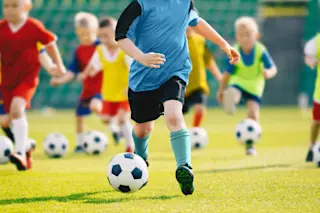When kids participate in sports, the benefits go far beyond the athletic field, as any lockdown-weary parent will tell you. Kids can burn off excess energy or relieve the cries of boredom.
Sporty kids feel better and have higher levels of concentration than kids who don’t participate in sports. And this means they’re more likely to get the top grades needed to enter selective schools at the age of 11, reveals a sub-cohort study in Bavaria from the Technical University of Munich (TUM).
Motor Skills
There’s a strong, positive correlation between kids’ physical fitness and their concentration levels, health-related quality of life and overall academic attainment, shows the study – which involved 3,285 girls and 3,248 boys between the ages of six and 10 years old.
Scientists say there’s a tangible advantage to promoting children’s gross and fine motor skills at an early stage. "Elementary school pupils with good physical fitness and ability to concentrate are more likely to make it to secondary grammar schools," explains Professor Renate Oberhoffer-Fritz who researches preventative pediatrics at TUM’s Department of Sport and Health Sciences.
"This means it's all the more important to encourage motor development in children at an early stage, since this can have a positive impact on the development of mental fitness,” adds Oberhoffer-Fritz.
Gross motor skills involve whole body movement and utilize the large core stabilizing muscles in the torso, legs and arms. They’re crucial for kids’ everyday activities such as sitting upright at the table or running across a playing field. And they form the basis of self-care tasks like dressing, where children need to stand on one leg to put their pants on without falling over.
You can promote skills like climbing, kicking and lifting to help your kids’ gross motor skills. Structured physical activity – or a mix of structured and unstructured physical activity – is the most effective means of enhancing a child’s gross motor skill development, shows a 2021 study in Psychology of Sport and Exercise.
Fine motor skills involve the use and coordination of the small muscles in areas like the hands, wrists and eyes. They influence the quality of a task outcome, as well as the speed it’s carried out.
You can set tasks involving precise movements like coloring, crafting and using building blocks to encourage the development of fine motor skills in kids. Along with the obvious benefits to muscle control, this aids hand-eye coordination and the simultaneous use of different muscles.
Encouraging Activity
When it comes to effectively boosting a kid’s fine motor skill development, a structured activity works best. This means that all those hours of messy play with sequins, poster paints and Lego bricks with a toddler contribute to their educational attainment years later.
Sporting activity can also impact the sexes differently. Physically fit boys perform better on overall fitness tests and fit girls perform better in terms of concentration and quality of life values, the study shows.
The results also highlight that body weight is a key predictor of kids’ physical and emotional health. Overweight children had significantly poorer results in all physical fitness tests – and lower self-esteem and general well-being – than underweight children and kids with a normal body weight.
These findings have implications for local policymakers and parent-teacher associations, too. Oberhoffer-Fritz observes, "Collaboration among parents, schools, communities and athletic clubs is very important when it comes to creating a comprehensive and appropriate range of possibilities."
Dr. Thorsten Schulz, head of the study team at TUM, says, "Based on the results of the study, the Berchtesgadener Land District Administration Office has been giving all first-grade pupils in the region a voucher for a one-year membership to a sports club. This is a great example of how different stakeholders can work together and help motivate children to be more athletically active."
It’s not yet clear how the relationship between sports participation and factors such as concentration levels, health-related quality of life and overall academic attainment evolves as children get older. The research team plans to investigate these changes in the coming months.
But in the meantime, we delight in the knowledge that sending elementary school kids out to play ball – while the adults get a moment of peace – is an effective way to boost the children’s’ academic achievement.














